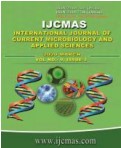


 National Academy of Agricultural Sciences (NAAS)
National Academy of Agricultural Sciences (NAAS)

|
PRINT ISSN : 2319-7692
Online ISSN : 2319-7706 Issues : 12 per year Publisher : Excellent Publishers Email : editorijcmas@gmail.com / submit@ijcmas.com Editor-in-chief: Dr.M.Prakash Index Copernicus ICV 2018: 95.39 NAAS RATING 2020: 5.38 |
Inferable from the impressive populace of wild relatives and forebears, the hereditary base of harvests was peaceful wide before taming. Through the span of time, hereditarily uniform improved assortments supplanted the profoundly differing nearby cultivars and landraces. These high yielding assortments have restricted inconstancy to battle the impact of biotic and abiotic stresses not at all like the Crop Wild Relative (CWR), which is an enormous store of agronomically critical characteristics. The usage of qualities from wild hereditary assets (CWR) for harvest improvement is entrenched with essential models going back over a century. In this paper, the data on the significance and use of wild qualities for expanding efficiency, biotic and abiotic stress opposition in major developed harvests is audited. Be that as it may, to use the CWR, surveying the decent variety, recognizing of characteristic of enthusiasm, expanding assorted variety of the distinguished quality and increase the hereditary assets. The usage of wild qualities was restricted to same species because of monotonous methodology in between intersection of species from various quality pools. In any case, with advances in sub-atomic techniques for overseeing backcrossing, bridge crossing, physical hybridization and transgenic approaches there was a spurt in use of wild relatives. Still there might be number of qualities, which are not recognized, can contribute in building up maintainable farming creation. CWR is additionally one among the assets which might not have completely investigated for their agriculturally vital qualities and those qualities will be lost with eradication of CWR. Along these lines, there is an earnest need with CWR recognizable proof as well as in their increase, insurance and their use, which will contribute enormously for guaranteeing nourishment security through adequate generation and accomplishing manageability in agribusiness.
 |
 |
 |
 |
 |